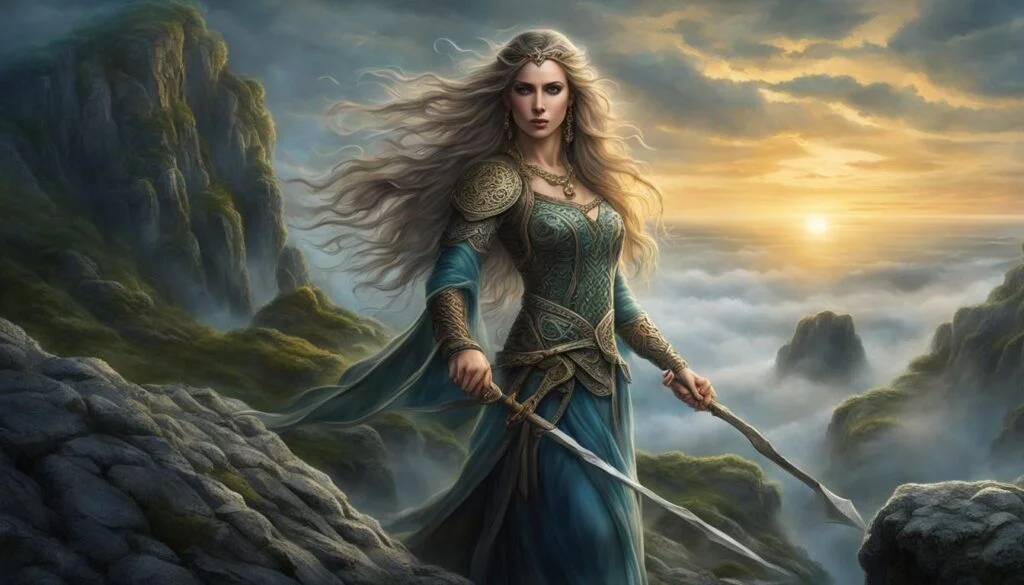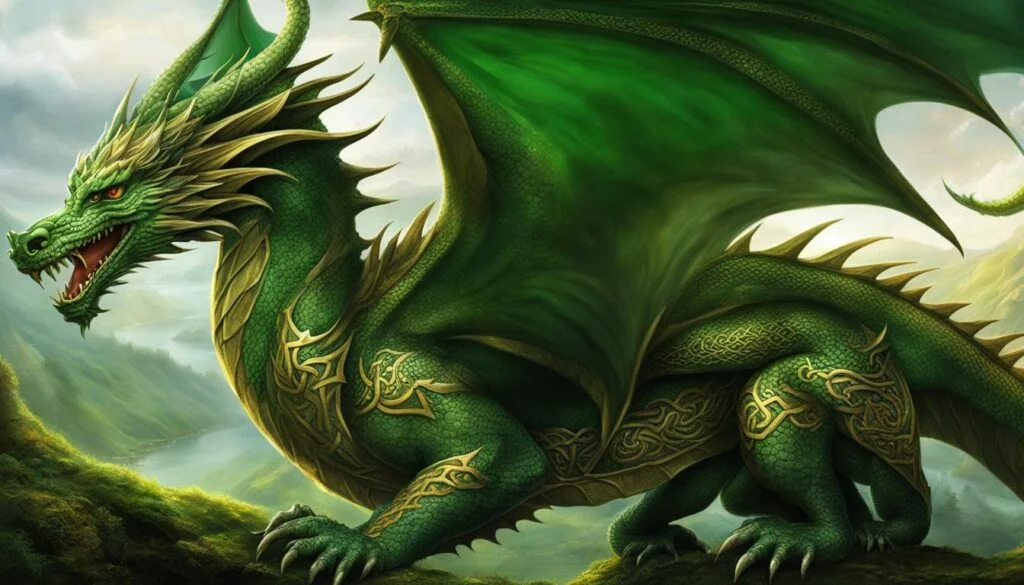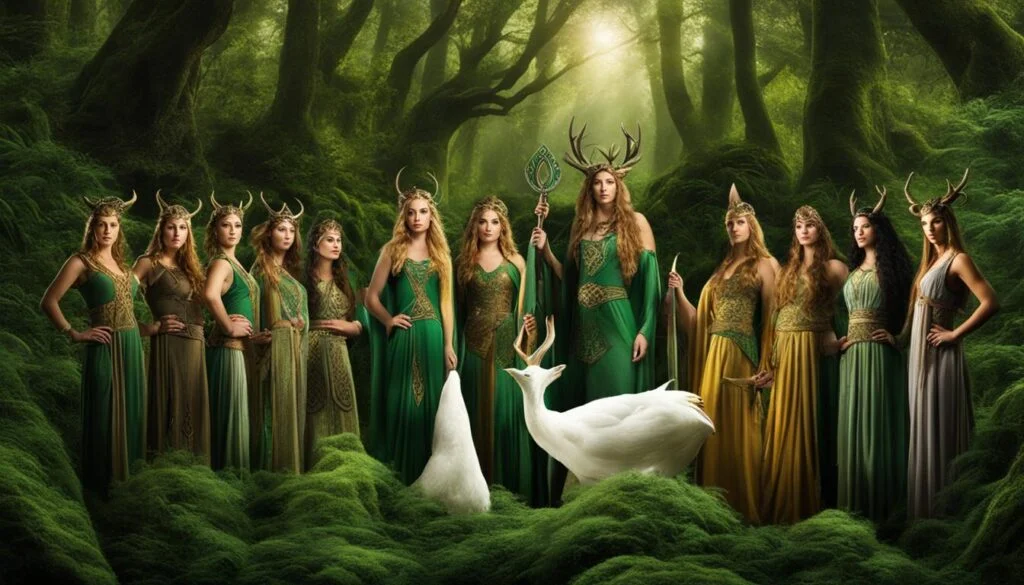In Celtic mythology, the ancient Celtic pantheon is rich with gods and goddesses, each holding great power and significance. Among these divine beings, there are several powerful female deities who are celebrated for their strength and influence. Exploring the ancient Celtic pantheon allows us to uncover the most powerful Celtic goddess and understand the profound role of the divine feminine in Celtic mythology.
Key Takeaways:
- The Celtic pantheon is home to numerous powerful goddesses who played significant roles in ancient Celtic culture.
- Ancient Celtic mythology recognizes the importance of the divine feminine, honoring the extraordinary power and wisdom of these female deities.
- Ancient Celtic goddesses were worshipped and revered by their communities, with their names and symbols holding deep spiritual significance.
- The stories and legends surrounding these powerful Celtic goddesses offer valuable insights into ancient goddess worship and the cultural beliefs of the time.
- Exploring the most powerful Celtic goddess allows us to connect with our own divine feminine nature and embrace the ancient wisdom passed down through generations.
The Dagda – Leader of the Celtic Pantheon
The Celtic pantheon is filled with powerful gods and goddesses, each holding their own unique abilities and significance in Celtic mythos. At the forefront of this divine assembly stands The Dagda, a truly formidable figure and the leader of the Celtic pantheon.
The Dagda is often likened to renowned gods from other mythologies, such as Odin in Norse folklore and Zeus in Greek mythology. With his wisdom, strength, and prosperity, The Dagda holds great influence over the Celtic deities, taking charge from his divine throne within the realm of the Tuatha dé Danann.
Belonging to the Tuatha dé Danann, a race of supernatural beings, The Dagda’s presence commands respect and reverence. His status as the leader of the Celtic pantheon underscores his immense power and authority, making him a central figure in Celtic mythos.
As we delve deeper into the enchanting world of Celtic mythology, we begin to uncover the captivating stories of other prominent deities such as Danu, The Morrigan, Aengus, Cliodhna, Lugh, Brigit, Taranis, and Balor. Each of these divine beings adds another layer of depth and richness to the ancient tales that have captivated countless generations.
Danu – The Matriarch of Power
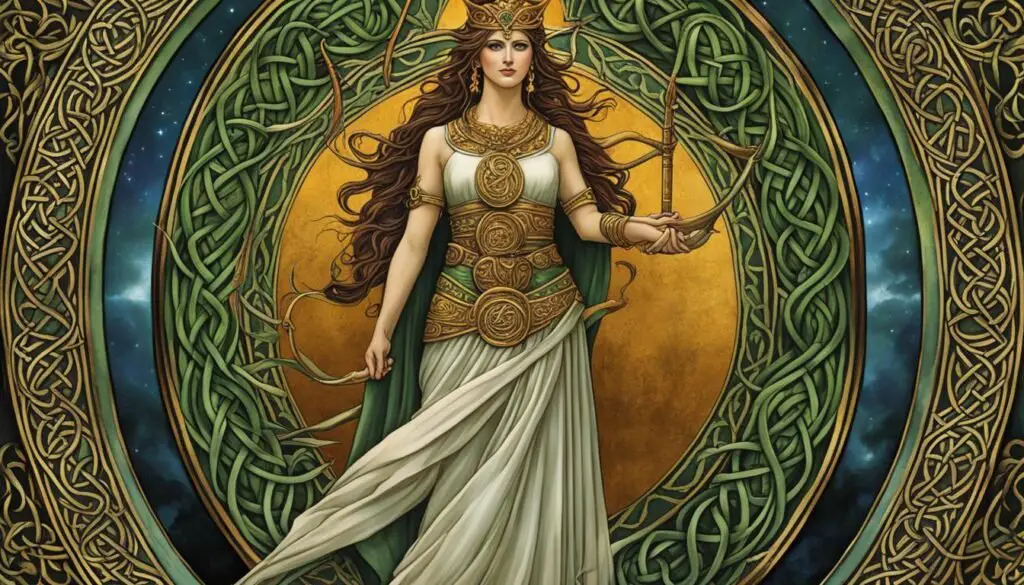
In the Celtic pantheon, Danu holds the esteemed title of the matriarch of power. As the counterpart to The Dagda, she embodies the strength and authority that are central to the ancient Celtic deities.
Danu’s association with water is symbolized by fish and seagulls, creatures that inhabit the watery realms. This connection to water represents her role as a source of life and vitality in Celtic mythology.
The triple goddess symbol is closely linked to Danu, representing the three aspects of womanhood: maiden, mother, and crone. This emblem serves as a powerful representation of the divine feminine and the cyclical nature of life.
While the details of Danu’s role in the Celtic creation myth are surrounded by speculation and ambiguity, she is widely believed to be the ancestral figure from which the Celtic gods trace their lineage. Her presence in the pantheon serves as a testament to her enduring influence and power.
Uncover the tales of Danu and delve deeper into the intricate Celtic pantheon, where the divine feminine reigns supreme and captivating myths unfold.
The Morrigan – Celtic Version of the Valkyrie

The Morrigan is a powerful Celtic goddess associated with war and often depicted as a crow. Similar to the Nordic Valkyries, she embodies the fierce spirit of battle and inspires warriors to be heroic and brave. In Celtic folklore, many victorious battles are attributed to her guidance and protection.
The Morrigan’s presence is often linked to the god of war, and her association with warfare is deeply ingrained in Celtic mythology. Her divine influence extends beyond the battlefield, as she is believed to possess the ability to shape destiny and influence the outcomes of conflicts.
Legend has it that The Morrigan played a significant role in Arthurian legends, particularly as the evil sister Morgana. Her shadowy presence and cunning nature added a layer of intrigue and complexity to the tales of King Arthur and his knights.
With her crow form as a symbol, The Morrigan embodies both the beauty and darkness of war, reminding us of the duality of life. Her enigmatic nature and relentless pursuit of justice make her one of the most intriguing figures in Celtic mythology.
Aengus – Celtic God of Love
Aengus is a prominent Celtic god known for his role as the god of love. In Irish myths, he holds a significant place, often compared to the Greek god Cupid. Aengus is associated with passion, desire, and the magic of romance.
As the god of love, Aengus carries mythological artifacts that symbolize his power and influence. He wields swords and spears, representing both the tender and fierce aspects of love. Aengus is not only a lover but also a fighter, embodying the multifaceted nature of love itself.
One of Aengus’s most famous stories involves his love affair with a swan-woman named Caer Ibormeith. In this captivating tale, Aengus transforms himself into a swan to join Caer in her flight across the sky. Their love transcends boundaries and showcases the enchanting power of Aengus’s love.
Aengus’s association with a white horse further emphasizes his significance as the god of love. The horse, known as “Enbarr of the Flowing Mane,” possesses unique abilities, including the ability to travel over land and water. This symbolism represents the transformative journey of love, transcending physical boundaries and bringing people together.
The stories surrounding Aengus epitomize the captivating and enduring power of love in Celtic mythology. His representation as the god of love contributes to the richness of Irish myths and legends, intertwining fantastical elements with human emotions.
Cliodhna – Goddess of Beauty
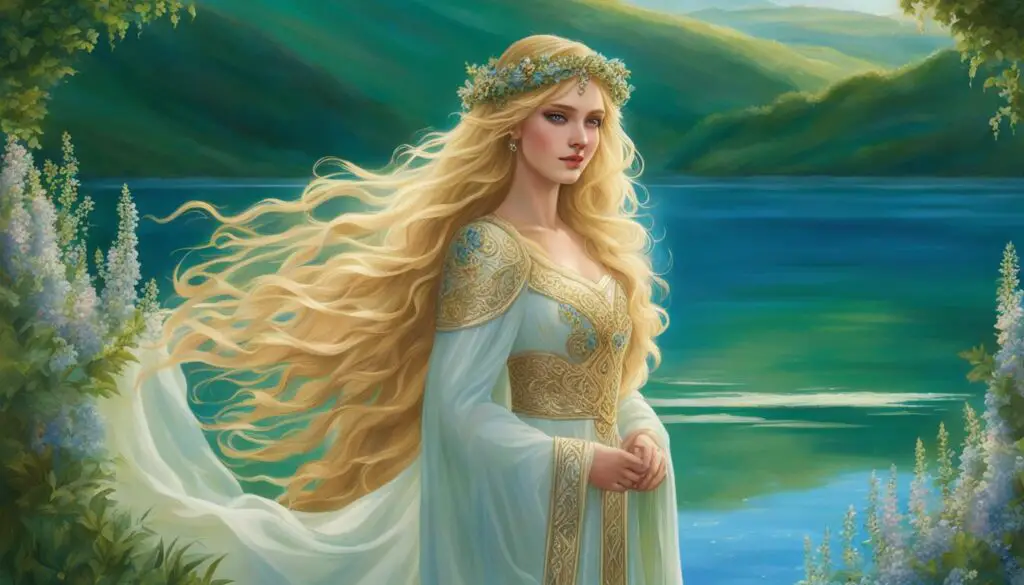
Cliodhna is a Celtic goddess associated with beauty and is often regarded as the epitome of divine allure. In Celtic mythology, she is revered for her captivating appearance and her ability to inspire awe with her enchanting presence.
One of the most prominent symbols associated with Cliodhna is the image of triple birds. These birds, often depicted in vibrant colors, serve as a representation of the goddess’s beauty and grace. The triple birds symbolize the transcendent power of Cliodhna’s allure, captivating all who encounter her.
Not only is Cliodhna a goddess of physical beauty, but she is also revered for her healing abilities. In Celtic folklore, she is believed to possess the power to bring restoration and rejuvenation to those in need. Her healing touch is said to be gentle, soothing, and capable of transforming both body and spirit.
Despite her association with beauty and healing, Cliodhna’s story takes a dark turn in some versions of Celtic mythology. In these tales, she is believed to become the queen of banshees, supernatural beings associated with death and mourning. This dual nature of light and darkness adds an intriguing depth to Cliodhna’s character.
Cliodhna is also notably connected to the legend of the Blarney Stone in Ireland. According to folklore, those who kiss the Blarney Stone are bestowed with the gift of eloquence and persuasive speech. Cliodhna’s association with this legend further emphasizes the captivating power she possesses.
As we delve deeper into the world of Celtic mythology, the story of Cliodhna continues to captivate our imagination. Her beauty, healing abilities, and association with the triple birds symbolize the enchanting allure she embodies. Whether she reigns as a goddess of beauty or becomes the queen of banshees, Cliodhna serves as a testament to the complexities and mysteries of the divine feminine in Celtic culture.
Lugh – Irish Mythological Warrior God
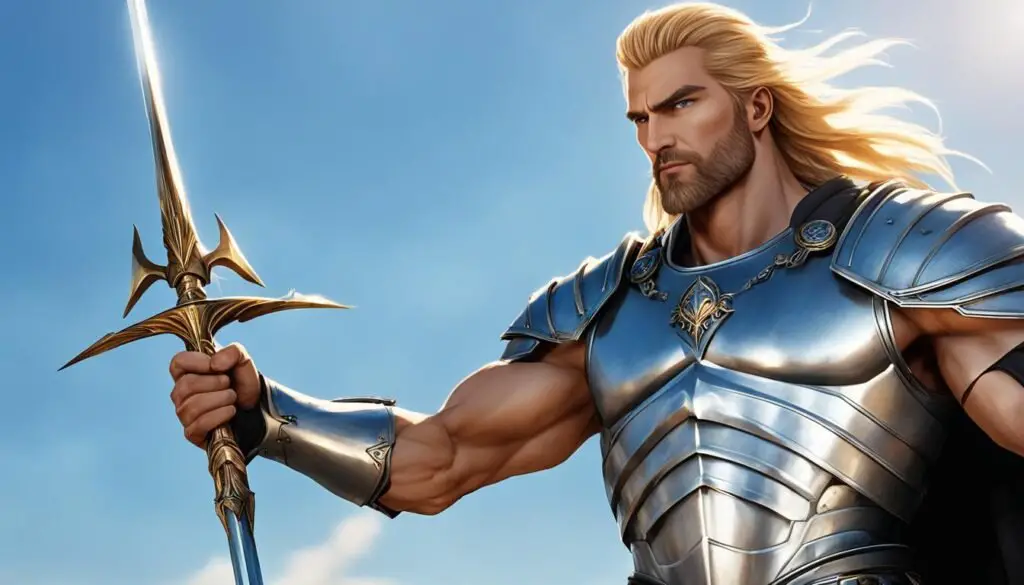
Lugh, also known as Lú, is a prominent Celtic warrior god in Irish mythology. He is revered for his prowess in battle and is often depicted wielding a flaming sphere, symbolizing his power and ferocity. Lugh is associated with the sun and is known as a solar deity, bringing light and warmth to the world.
As a warrior god, Lugh played a crucial role in Celtic warfare, leading armies and inspiring his followers to victory. But his stories go beyond the battlefield. Lugh is also credited with being the creator of sporting events, introducing games and competitions to the Celtic people. His influence in the realm of sports and athleticism connects him to the pursuit of physical excellence and fair competition.
Lugh’s tales often align with folk hero narratives rather than traditional godly myths. He is celebrated as a courageous and clever hero, using his wit and skill to overcome challenges and adversaries. Lugh’s adventures and accomplishments make him a beloved figure in Celtic folklore.
Interestingly, Lugh shares similarities with Nordic counterparts, particularly the renowned god Thor. Both Lugh and Thor are associated with lightning and storms, embodying the power of thunder and destruction. Their shared attributes and mythical roles illustrate the interconnectedness of ancient cultures and their pantheons.
Brigit – Goddess of Protection and Wisdom
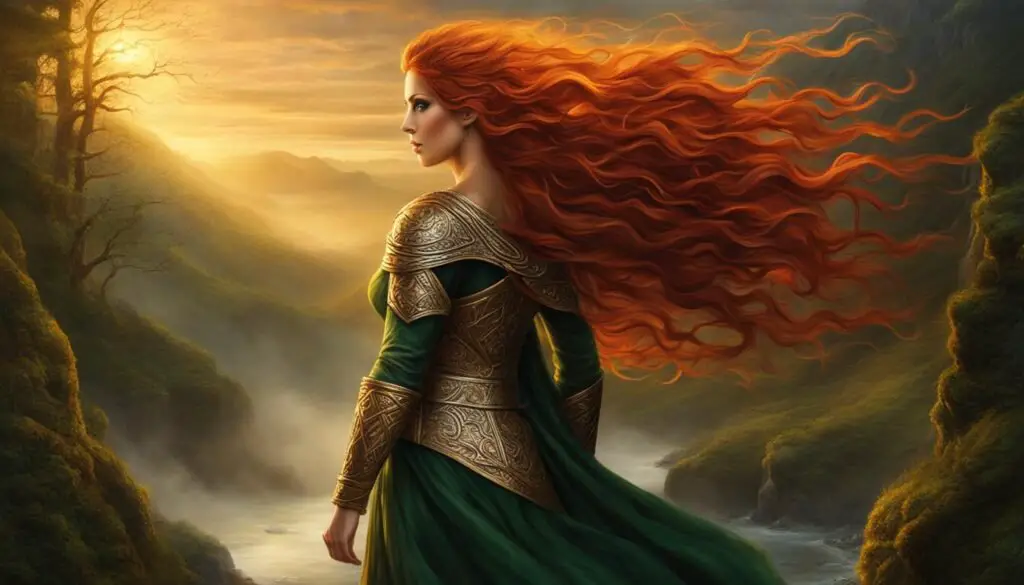
Brigit, the Celtic goddess of protection and wisdom, holds a prominent place in Celtic mythology. She is often revered as the patron saint of healing and inspiration, and her influence extends beyond the realms of the divine.
With her fiery spirit and deep connection to fire, Brigit symbolizes the transformative power of flames and the warmth they bring to our lives. She is associated with the sacred wells that provide life-giving water, nourishing both our bodies and souls.
Brigit’s presence is also felt in the pastoral realms, as she is the guardian of cattle. Her watchful eye ensures the well-being and prosperity of these cherished animals, a vital source of sustenance in Celtic culture.
Not limited to her protective role, Brigit embodies wisdom and inspires deep insight. Her wisdom is like a wellspring flowing, guiding seekers of truth along their spiritual journey.
Brigit – The Inspirational Figure
Brigit’s influence goes beyond Celtic mythology. She is believed to be the inspiration behind the Christian saint, St. Brigid, whose legacy is still honored today.
Worshiped as the goddess adored by poets, Brigit embodies the creative spirit and the power of artistic expression. She sparks the divine spark within us, igniting our imaginations and fueling our passions.
Brigit’s wisdom, protection, and inspiration continue to resonate with those who seek her guidance. Her enduring presence serves as a reminder of the importance of finding strength, wisdom, and creativity in our lives.
Taranis – Celtic God of Thunder
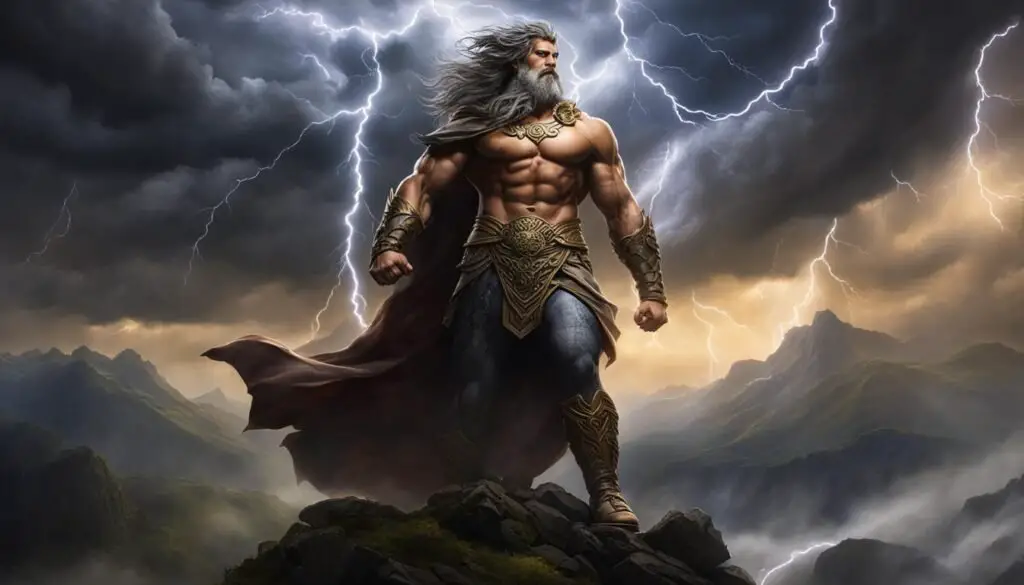
Taranis is a powerful Celtic deity associated with thunder and often compared to the Nordic god Thor. In Celtic mythology, he is revered as the god of thunder, storms, and natural forces. Taranis is depicted as a tall, bearded man who wields the power of lightning and storms.
As a worker deity, Taranis is often depicted in battle, fighting against a giant serpent that represents chaos and destruction. This symbolizes his role in maintaining order and protecting the Celtic realm from harm.
One of the significant symbols associated with Taranis is the wheel, representing his control over the celestial movements and the cycle of life. Another symbol associated with him is the lightning bolt, signifying his power to bring forth thunder and storms.
With his thunderous might, Taranis was deeply respected and worshiped by the ancient Celts, who believed in his ability to bring fertility, prosperity, and protection. His presence was influential in Celtic religious ceremonies and rituals, where offerings were made to appease his divine power.
Taranis Symbols:
- The Wheel
- The Lightning Bolt
Embodied with strength and authority, Taranis remains an iconic figure in Celtic mythology, representing the awe-inspiring force of thunder and the mighty power of nature.
Balor – Celtic God of Chaos
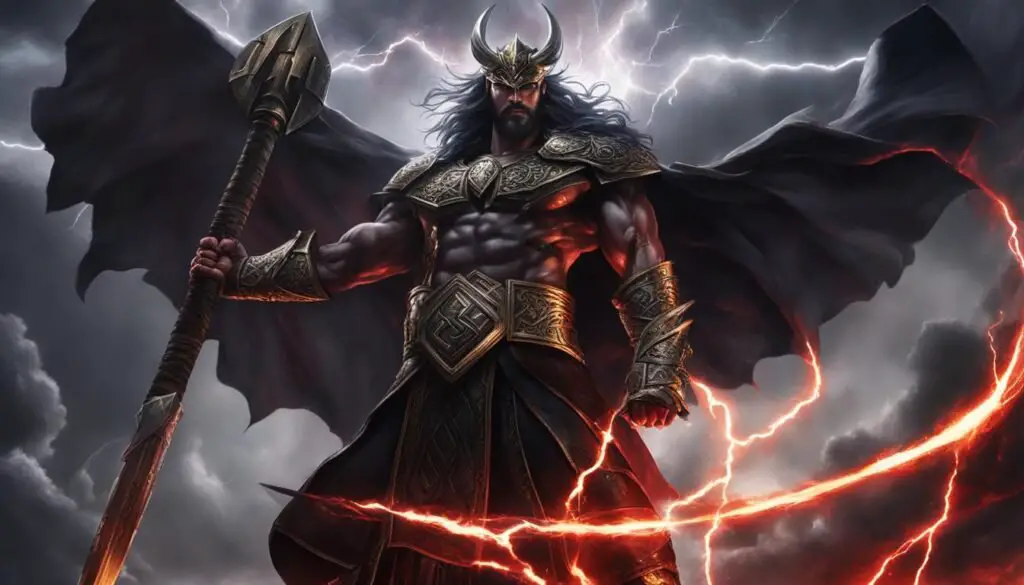
Balor, the Celtic god of chaos, is a formidable figure in Celtic mythology. As the leader of the Formorians, he represents the destructive forces that threaten the balance of the world. Balor is often depicted with one or three eyes, each possessing immense power.
Legend tells us that when Balor opens his eyes, chaos and destruction follow. His gaze has the ability to obliterate anything in its path, bringing devastation to those who encounter it. To prevent unintended destruction, Balor keeps his third eye covered, only revealing it when necessary.
The eye symbolism associated with Balor is powerful and significant. It represents his immense power and the potential for chaos that resides within him. This symbolism has had a lasting impact on Celtic mythology and has even influenced other works of literature.
It is believed that Balor’s eye symbolism served as inspiration for J.R.R. Tolkien’s portrayal of the eye of Sauron in his iconic fantasy novels. Just as Balor’s eyes symbolize chaos and destruction, the eye of Sauron represents evil and the all-seeing power of the Dark Lord.
Through Balor and his eye symbolism, Celtic mythology reminds us of the delicate balance of order and chaos that exists in the world. It serves as a cautionary tale of the destructive forces that can be unleashed when chaos is allowed to reign unchecked.
Conclusion
In Celtic mythology, the divine feminine is beautifully represented by powerful Celtic goddesses and ancient deities. These enigmatic figures hold significant roles in Celtic cultural celebrations and belief systems. By exploring their stories, we gain a deeper understanding of ourselves and our connection to the ancient world.
Celtic mythology is a rich tapestry woven with intricate tales of gods and goddesses, each with their unique powers and influence. The reverence for female deities in the Celtic pantheon showcases the importance of the divine feminine in their society. From Danu, the matriarch of power, to The Morrigan, the Celtic Valkyrie, we witness the strength and wisdom embodied by these powerful goddesses.
Delving into Celtic mythology allows us to appreciate the deep-rooted spirituality of the Celts. Their stories and beliefs, intricately intertwined with nature, offer insights into ancient wisdom and foster a sense of reverence for the divine feminine. These timeless legends and the powerful Celtic goddesses inspire us to embrace our own inner strength and connection to the sacred.
FAQ
Who is considered the most powerful Celtic goddess?
The most powerful Celtic goddess is The Dagda, the leader of the Celtic pantheon.
What is the significance of the divine feminine in Celtic mythology?
The divine feminine is of great importance in Celtic mythology, representing power, wisdom, protection, and beauty.
Are there other powerful Celtic goddesses in the ancient pantheon?
Yes, there are several other powerful Celtic goddesses, each with their own unique characteristics and roles.
What is the role of Danu in Celtic mythology?
Danu is considered the matriarch of power in the Celtic pantheon, associated with water, the triple goddess symbol, and the creation of Celtic gods.
Who is The Morrigan in Celtic mythology?
The Morrigan is a Celtic goddess often depicted as a crow, associated with war and inspiration of bravery in warriors.
What is Aengus known for in Celtic mythology?
Aengus is a prominent Celtic god associated with love, carrying mythical artifacts and having notable love affairs in his stories.
What is the significance of Cliodhna in Celtic mythology?
Cliodhna is a Celtic goddess associated with beauty, healing abilities, and the queen of banshees in some legends.
What is Lugh’s role in Celtic mythology?
Lugh is a prominent Celtic god revered as a warrior and the creator of sporting events, with stories resembling folk hero tales.
Who is Brigit and what is her association in Celtic mythology?
Brigit is a Celtic goddess associated with protection, wisdom, fire, and the inspiration for the Christian saint St. Brigid.
What is Taranis’ role in Celtic mythology?
Taranis is a Celtic god associated with thunder, often compared to the Nordic god Thor, and depicted as a tall, bearded man.
Who is Balor and what is his significance in Celtic mythology?
Balor is a Celtic god associated with chaos, the leader of the Formorians, and known for his destructive power and symbolic eye.
What can we learn from exploring the stories of Celtic goddesses in mythology?
Exploring the stories of Celtic goddesses allows us to delve into the divine feminine and gain insights into ancient culture and the significance of powerful female deities.


